Wars of the Diadochi › Theseus » Ancient origins
Articles and Definitions › Contents
- Wars of the Diadochi › Antique Origins
- Theseus › Who Was
Ancient civilizations › Historical and archaeological sites
Wars of the Diadochi › Antique Origins
Definition and Origins

On June 10, 323 BCE Alexander the Great died in Babylon. Although historians have debated the exact cause most agree that the empire he built was left without adequate leadership for there was no clear successor or heir. The military commanders who had followed the king for over a decade across the sands of Asia were left to fight each other over their small piece of the territorial pie. These were the Wars of Succession or Wars of the Diadochi. What followed were over three decades of intense rivalry. In the end three dynasties would emerge, remaining in power until the time of the Romans.
ALEXANDER 'S DEATH
In 334 BCE Alexander and his army left Macedonia and Greece in the capable hands of Antipater I and crossed the Hellespont to conquer the Persian Empire. Now, after a decade of fighting, King Darius was dead, dying at the hands of one of his own commanders, Bessus. Although many in his army wanted to simply return home, the new, self-proclaimed king of Asia was making plans for the future. His proposed Exile Decree called for all Greek exiles to return to their native cities ;however, as he sat in his tent at Babylon, trouble brewed throughout his empire. Many of his loyal troops not only protested the presence of Persians among their ranks but rebelled against his insistence that they take Persian wives. Several of the satraps - those he had put in charge to govern the occupied territories - were being executed for treason and malfeasance. After Alexander's death, other areas, even some closer to home, would seize the opportunity to revolt. Athens and Aetolia, upon hearing of the death of the king, rebelled, initiating the Lamian War (323 – 322 BCE). It took the intervention of Antipater and Craterus to force an end to it at the Battle at Crannon when the Athenian commander Leosthenes was killed.
Of course, Alexander did not live to fulfill his dreams. After a night of heavy partying, he fell ill; his health gradually deteriorated. There were those, his mother Olympias included, who claimed he had been poisoned in a supposed plot conceived by the philosopher and tutor Aristotle and Antipater, fulfilled by his sons Cassander and Iolaus. On his death bed, barely able to speak, the king handed his signet ring to his loyal commander and chiliarch (replacing Hephaestion ) Perdiccas. In a scene befitting a king, he died surrounded by his commanders. Questions exist to this day concerning Alexander's final words - “to the best.” - and what they meant. Since he had not specifically named a successor, the primary concern of those closest to the king, especially his commanders, was to choose a successor.
A SEARCH FOR A SUCCESSOR
Without Alexander, there was no government and no one had the authority to make decisions. Apparently, since he had treated his commanders equally, not wanting to create rivalry, his final words were meaningless. There was no one considered “the best.” There were, however, two likely candidates that could be considered as a possible successor. First, there was Alexander's half-brother Arrhidaeus, the son of Philip II and Philinna of Larissa. He was already in Babylon. Next, one might consider waiting until the child of Alexander's Bactrian wife Roxanne was born, but the future Alexander IV would not be born until August.
WITHOUT ALEXANDER, THERE WAS NO GOVERNMENT & NO ONE HAD THE AUTHORITY TO MAKE DECISIONS.
According to one historian, the struggle for leadership would be more bitter and destructive than the decade-long war against the Persians. The commanders were split: some favored Arrhidaeus, others wanted Alexander's unborn son, and then there were those who wanted to simply divide the empire among themselves. Perdiccas favored Roxanne and the future Alexander IV. For self-centered reasons, Perdiccas preferred Alexander's wife and child; he would then be able to serve as regent for the young king. Later, with Perdiccas's approval, Roxanne, favoring her son as the only true heir, chose to eliminate any competition, even if there were no children, by killing Alexander's wife Strateria, the daughter of Darius, and her sister Drypetis.To add insult she threw their bodies down a well.
Hoping to maintain a unified empire, Perdiccas brought the commanders together to decide on a successor. Many disliked the idea of waiting for the birth of Roxanne's child. Roxanne was not a pure Macedonian. One commander even suggested Alexander's four-year-old son, Heracles, by his mistress Barsine, but this idea was easily dismissed. Some looked to Arrhidaeus, and even though he was considered mentally handicapped, he was still the half-brother of Alexander and a Macedonian. The infantry commander Meleager and a number of his fellow infantry staged a revolt, choosing Arrhidaeus as the successor and even naming him Philip III. Meleager disliked Perdiccas, considering him a threat to the state. He even tried to arrest him. Seeing this as a betrayal, Perdiccas had Meleager executed in the sanctuary where he had sought refuge. The revolt was quietly suppressed. Some commanders decided to briefly put aside their differences and wait for the birth of Roxanne's child with guardians even being appointed to oversee the safety of both the child and the newly crowned Philip III.The regent Antipater would eventually have both of them brought to Macedon for safety.

Alexander The Great and Roxane
However, the death of Meleager changed the attitude of many of the commanders and set in motion the decades of war that would follow. From 323 to 281 BCE the intense competition between the commanders would escalate, as they wrestled for the control of Greece, Macedon, Asia Minor, Egypt, Central Asia, Mesopotamia and India. Although there would be brief periods of peace, the empire would never be reunited. In the end there was only one solution: the Partition of Babylon divided Alexander's kingdom among the more prominent commanders - Antipater and Craterus received Macedon and Greece, Ptolemy grabbed Egypt deposing Cleomenes, the bodyguard Lysimachus was awarded Thrace, Eumenes gained Cappadocia, and lastly, Antigonus the One-Eyed remained in Greater Phrygia.
THE SUCCESSOR WARS
The four Successor Wars centered on the aspirations of three individuals and their descendants: Antigonus Monophthalmus I (382 - 301 BCE), Seleucus I Nicator (358 – 281 BCE) and Ptolemy I Soter (366 – 282 BCE). It would be their heirs who formed the dynasties that would exist for two more centuries. The great empire that Alexander had built extended from Macedon and Greece, eastward through Asia Minor, southward through Syria to Egypt, and eastward again through Mesopotamia and Bactria and into India. No empire like it had ever existed, and none of the successors would ever achieve anything equal to it. From Alexander's death in 323 BCE to the death of Lysimachus in 281 BCE, the old commanders fought, making and breaking numerous alliances - all with the selfish intentions of extending their own land holdings - no one could depend on another's loyalty.

Seleucus I Nicator
With the empire divided at Babylon, the commanders made their way home. Lysimachus would have to deal with a Thracian rebellion, Antipater and Craterus fought Athens and her allies in the Lamian War, and Ptolemy had to establish himself in Egypt. The new pharaoh also had to look across the Nile and determine his next move against Perdiccas. Despite their selfish concern over land, there was one commonality among all of the commanders: no one liked Perdiccas, and Perdiccas hated Ptolemy above all others. It was very obvious from the beginning that these two men would never agree. The two had even quarreled at Babylon when Perdiccas had wanted to wait for Alexander's son to be born while Ptolemy wanted to divide the empire.
As the king's chiliarch, Perdiccas had established himself securely after Alexander's death, always hoping to reunite the empire. He had the signet ring and the king's body, preparing to return it to Macedon and a newly prepared tomb. However, at Damascus the body mysteriously disappeared - stolen by Ptolemy and taken to Memphis in Egypt. Now, with the kidnapping of the body, the long disagreement finally ended in war (322 – 321 BCE). Three failed attempts to cross the Nile into Egypt cost Perdiccas his life; he own army tired of his failure and the death of 2,000 men and killed him. Some even believe Seleucus, a one-time ally of Perdiccas, was involved. Under Alexander, Seleucus had been the commander of an elite corps of hypaspists, yet he did not acquire any territory at Babylon. Instead, he was named the commander of the Companion Cavalry.His loyalty to Ptolemy in the fight against Perdiccas, however, brought him the province of Babylonia.
The First Succesor War ( 322- 320 BCE) was all about jealousy. Before his confrontation with Ptolemy, Perdiccas had already alarmed both Antipater and Craterus in Macedon as well as Antigonus in Phrygia by his army's invasion of Asia Minor. The arguments over territory began when Perdiccas became furious at Antigonus because he refused to help Eumenes keep control of his allocated territory, Cappadocia. Eumenes was the commander of Perdiccas's forces in Asia Minor. Antigonus wanted to avoid a conflict with Perdiccas and Eumenes, so he and his son Demetrius sought refuge in Macedon. They joined forces with Antipater, Craterus, Ptolemy, and Lysimachus against Perdiccas and Eumenes. Unfortunately, Craterus died in battle when he own horse fell on him. After Perdiccas's death, Eumenes became isolated, condemned to death in the Treaty of Triparadeisus.

Ptolemy_I
THE TREATY OF TRIPARADEISUS
Under the guidance of Antipater, the new treaty at Triparadeisus in 321 BCE secured many of the commanders in their allotted territories. Later, when Antipater died in 319 BCE, Cassander, his son, was not named the heir to the regency of Macedon and Greece but instead was made a cavalry commander. Antipater did not believe his son was capable of defending Macedon against the other regents. In his place, Antipater appointed a commander named Polyperchon as regent. This slight would lead to a series of conflicts between the two - Cassander would ally himself with Lysimachus and Antigonus while Polyperchon would align himself with Eumenes and later the dowager queen Olympias. However, the year 319 BCE would bring an end to the first war - Perdiccas, Craterus and Antipater were dead, Seleucus was firmly established in Babylonia, Ptolemy occupied Egypt, Lysimachus sat in Thrace, and Antigonus held much of Asia Minor. The only place of discontent was in Macedon and Greece where Cassander and Polyperchon were preparing to battle.
THE SECOND & THIRD SUCCESSOR WARS
Over the next decade the Second Successor War (319 - 315 BCE) and Third Successor War (314 - 311 BCE) would bring about a number of dramatic changes. Cassander would roust Polyperchon from Macedon and Greece, and with the help of Antigonus establish bases at Piraeus and on the Peloponnese. And to further secure his right to sit on the Macedonian throne, he would marry the daughter of Philip II, Thessalonica. By 316 BCE at the Battle of Gabiene, Antigonus would finally be victorious against Eumenes gaining control of much of Asia- he had been ordered by Antipater at Triparadeisus to hunt down Eumenes. Eumenes would later be executed in 316 BCE after his own men betrayed him, surrendering him to Antigonus. Unfortunately, Seleucus would lose his hold on Babylonia after Antigonus's invasion, seeking refuge with Ptolemy.Luckily, he would regain his territory in 311 BCE, eventually establishing a new capital, Seleucia.
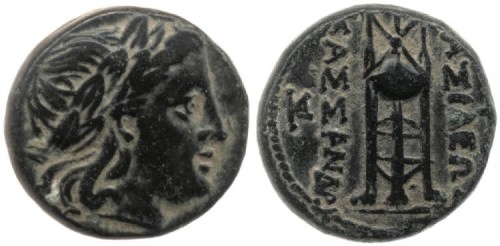
Cassander
The Peace of the Dynasts was concluded in 311 BCE but quickly ended when another war, the Babylonian War (311- 309 BCE) kicked off when Seleucus invaded Babylonia with Ptolemy's support against Antigonus and his son Demetrius, regaining his lost territory at the Battle of Gaza.
In Thrace Lysimachus had been having trouble with one of the cities along the Black Sea coast. Setting his sights on the strategically important province for himself, Antigonus sent a small army to aid the city and provoke the local tribes. Finally, in 311 BCE, peace was achieved with Lysimachus remaining in control of the city, but this revolt finally drew him into the conflict that he had so long sought to avoid. He soon formed an alliance with Cassander, Ptolemy, and Seleucus.
IN 310 BCE CASSANDER ORDERED THE DEATH OF BOTH ALEXANDER IV & HIS MOTHER ROXANNE.
Meanwhile, in Alexander's old homeland, Macedon, Cassander was continuing his battle against Polyperchon. Earlier, Polyperchon had fled to Epirus and aligned himself with Olympias, hoping to invade and reclaim Macedon. Cassander realized that as long as Olympias and the young Alexander IV remained alive, they would be a threat to his hold on Macedon. In 316 BCE she had ordered the assassination of her step-son Philip III - his wife Eurydice would commit suicide. In 310 BCE Cassander ordered the death of both Alexander IV and his mother Roxanne. Olympias would also die, with dignity, at the hands of his soldiers.
THE FOURTH SUCCESSOR WAR
In the Fourth Successor War (308-301 BCE) Cassander and Ptolemy would continue to have troubles with Demetrius I of Macedon, “the Besieger of Cities”, when he invaded Greece and “liberated” Athens in 307 BCE from Cassander's governor.Later, in 302 BCE, he reinstituted the old League of Corinth. Meanwhile, Ptolemy had gradually been expanding northward, securing the island of Cyprus, only to lose to Demetrius at Salamis. Next, Demetrius chose to attack Rhodes but thanks to Ptolemy and his allies (Seleucus, Lysimachus, and Cassander) the siege ended in negotiations. That same year, 305 BCE, the various commanders declared themselves to be kings. By 303/302 BCE the war continued as Cassander fought to keep Demetrius and Antigonus out of Macedon. Cassander had little choice but call to his allies for help. Lysimachus moved his forces into Asia Minor causing Demetrius to abandon Greece and join his father. The Battle of Ipsus brought Lysimachus, Seleucus, and Cassander against Antigonus and Demetrius. The battle would cause not only the death of Antigonus but the end of any hope of restoring Alexander's empire. Lysimachus and Seleucus divided Antigonus's territory with the former getting lands in Asia Minor while the latter took Syria where he would ultimately build the city of Antioch.
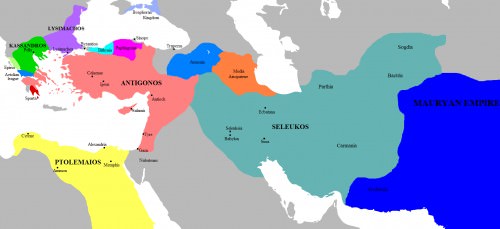
Map of the Successor Kingdoms, c. 303 BCE
LYSIMACHUS AGAINST SELEUCUS
Although Cassander sat securely in Macedon, his safety would not last. He died in 297 BCE leaving his homeland to the army of Demetrius who declared himself king of Macedon and Greece. The victorious Lysimachus began to expand his territory further. After the death of his old ally Cassander, he set his sights on Macedon. With the assistance of King Pyrrhus of Epirus, he crossed the border and forced Demetrius out. Demetrius and his army escaped across the Hellespont and into Asia Minor, confronting the army of Seleucus. Unfortunately for Demetrius, he was immediately captured only to die in captivity in 283 BCE, although his descendants would eventually regain Macedon and Greece.
In 282 BCE Lysimachus's one-time ally Seleucus set his sights on Lysimachus's territory in Asia Minor, and in 281 BCE the two armies met at Corupedium where Lysimachus met his death. The commander who had not received any land at Babylon and, at one point, lost what little he did gain, proved to be the true winner. Unfortunately, victory would have to be celebrated by his descendants. He would die at the hands of Ptolemy's son Ptolemy Ceraunus in 281 BCE.
The death of Alexander the Great in 323 BCE had brought chaos. His failure to name a successor or heir left his commanders to eventually divide the empire among themselves. Jealousy led to over three decades of war where alliances were made and broken. The four wars of the diadochi would usher in the Hellenistic Period and bring into existence three dynasties that would exist until the time of the Romans.
Theseus › Who Was
Definition and Origins
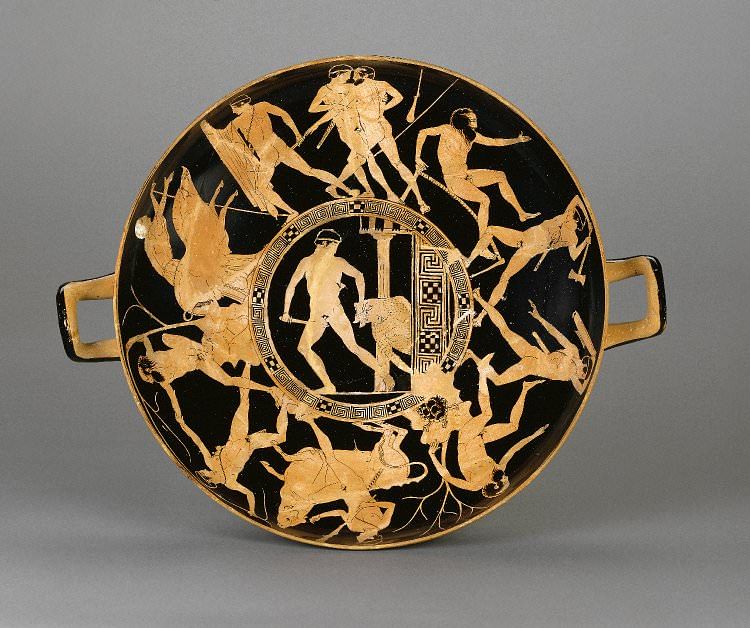
Theseus is a legendary hero from Greek mythology who was considered an early king of Athens. Famously killing villains, Amazons, and centaurs, his most celebrated adventure was his slaying of the fearsome Minotaur of the Cretan king Minos. In the Classical period, Theseus came to represent the perfect Athenian - the just man-of-action determined to serve his city as best he could and staunch defender of democracy. The hero appears in several Greek tragedy plays and his battle with the Minotaur was a favourite of Greek vase painters. He is the subject, too, of one of Plutarch ’s Lives biographies.
EARLY ADVENTURES OF THESEUS – THE LABOURS
In legend, Theseus' father was considered either the son of the god Poseidon or King Aegeus of Athens. His mother was Aethra, daughter of Pittheus, the king of Troezen, whom Aegeus seduced. Theseus spent his childhood at Troezen in the northeast of the Peloponnese as Aegeus had warned Aethra not to tell her son who his real father was until he came of age, perhaps explaining why Theseus was considered the son of Poseidon in his youth. When a young adult, the hero gathered up gifts of sandals and a sword from his father which had been buried under a heavy rock for when he was old enough to lift it.With these tokens Theseus set off for Athens to claim, as Aegeus' only son, his inheritance, the kingdom of Athens. Before he could reach the city, though, he first had to battle various villains and monsters.
The first villain to be dispatched was Periphetes, who smashed the heads of anyone he came across with a huge iron club.Theseus killed him without ceremony and took his club as a handy weapon for his future adventures. A similar baddy was Sinis (also Sines) who hung around the Corinth countryside and bent pine trees so that they might strike and kill people who passed through the Isthmus. Our hero killed the troublesome Sinis using, of course, a bent pine tree. According to Plutarch, Theseus had a son, Melanippus, by Sinis' daughter Perigune.
Next came Skiron who blocked the narrow sea passage through the rocks of Megara. He took delight in forcing people to wash his feet and when they bent down to do so he would kick them over the cliff and into the sea. Whether the unfortunate travellers survived the fall or not was irrelevant as, in any case, they were then eaten by a giant turtle that haunted those parts.All this frightful behavior was put to an end by Theseus who kicked Skiron into the sea to be eaten by his own accomplice or, in another version, to be turned into a rock.
THESEUS WAS THE GREAT HERO OF ATHENS WHO BATTLED THE MINOTAUR, AMAZONS, CENTAURS, & VILLAINS.
Next in line came Kerkyon, the champion wrestler who crushed to death anyone who passed his way, but Theseus beat him at his own sport. The last scoundrel was Prokroustes (also Procrustes or Damastes) who waylaid travellers and forced them onto a bed; if they were too tall for the bed he would chop off the excess, if they were too short he would stretch them using weights or hammer their limbs to increase their length. Theseus swiftly dealt with him too by putting him on his own device.
Finished with littering the Greek countryside with dead villains, Theseus then had to kill a bad-tempered sow called Phaia which was causing trouble, again, in the Corinth area. He finally did arrive at Athens, where he was not helped by his jealous step-mother Medea. She and Theseus' cousins, the Pallantidae, tried several times to do away with our hero but their ambushes and poisonings came to nothing. Medea then sent Theseus off on the dangerous errand of dealing with the bull of Marathon which was terrorizing the countryside. The hero captured the animal and sacrificed it to Apollo. In yet more adventures, Theseus even found time to help Meleager in the Calydonian Boar hunt and to accompany Jason and his Argonauts on their quest to find the Golden Fleece, but his greatest trial was yet to come.
THESEUS & THE MINOTAUR
Theseus' most famous adventure was his slaying of the Minotaur of King Minos on Crete. Every year (or every nine, according to Plutarch) Athens was compelled to send seven young men and seven young women to feed this fearsome creature with a man's body and the head of a bull, which dwelt in the mysterious labyrinth at Knossos, built by the famed architect Daedalus. The terrible tribute was, in some sources, compensation for the death of Minos' son Androgeous, killed by jealous competitors after he won at the Athenian Games (in other versions he was killed by the bull of Marathon). The unique Minotaur came from the union of Minos' wife Pasiphae and a bull after the queen was made to fall in love with the animal by Zeus as revenge for Minos' refusal to sacrifice it in the god's honour.
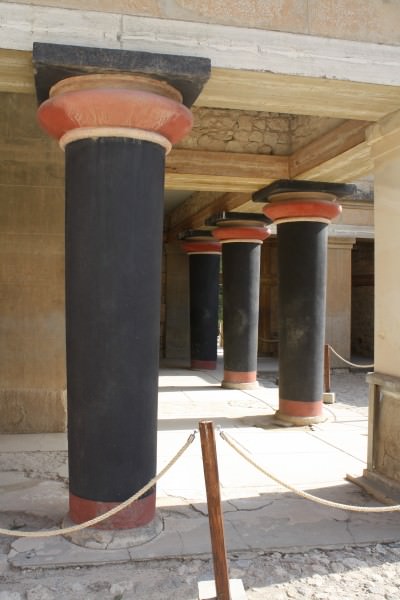
Labyrinth of Knossos
Theseus, seeking to put a stop to this barbarity, enrolled himself as one of the seven youths and sailed to Crete. On the way, our hero, with the help of Amphitrite, Poseidon's wife, retrieved a ring which had been thrown into the sea by Minos. On arrival Theseus fearlessly entered the lair of the Minotaur from which no one had ever come out alive. There, with the help of Ariadne, daughter of Minos, the hero marked his way through the winding passages of the labyrinth using a ball of string. Striking down the beast with his sword, he easily followed the string back to the labyrinth's entrance and freed Athens from her terrible obligation to Minos.
Sailing back to Athens, Theseus rather ungallantly abandoned Ariadne on the island of Naxos, perhaps on the advice of Athena, but she soon found solace in the arms of the god of wine Dionysos, whom she married. In another version she is killed by Artemis, acting on instructions from Dionysos, who had once been betrothed to the princess and was miffed to have lost her to Theseus. The hero then stopped at Delos, offered a sacrifice to Apollo, and performed what would become a famous dance, the geranos or Crane dance, which mimics the movements inside the labyrinth.

Minotaur
Theseus then sailed on home but was hit by tragedy when he forgot, as he had promised to his father before setting off, to hoist a white sail instead of the usual black one (set as a mark of mourning for the doomed youths) which would signal to his waiting father that all was well. Theseus' father saw the black sail, thought his son had been killed by the Minotaur and, utterly distraught, threw himself off the cliff into the sea below. Thereafter, the sea carried his name, the Aegean. Theseus thus inherited the throne and he settled down to government, unifying the many small settlements of the area into a single political unit (synoecism), and establishing a peaceful and prosperous period for Athens.
BATTLING AMAZONS, CENTAURS & HADES
This was not the end of Theseus' adventures as he was involved in several other myths too. He fought the Amazons alongside Hercules when they invaded Attica to regain the girdle of their queen Hippolyta, aka Antiope, which Hercules had stolen as one of his labours. In some accounts, Hippolyta was Theseus' first wife and together they had a son, Hippolytos. Next up, Theseus fought the centaurs, the half-man, half-horse creatures, which had disrupted the wedding of Theseus' good friend Pirithous (Peirithoos) of the Lapiths.
Theseus then tried to abduct Persephone from Hades in the underworld so that Peirithous might marry her. Hades was not to give up his bride so easily (especially after the trouble taken to get her down there in the first place) and he tricked the pair into sitting on thrones which entrapped them. Theseus was only rescued by the exploits of Hercules, who had come to capture Cerberos in his final labour, but Peirithous was, alas, left to his fate.

Centaur & Lapith Metope, Parthenon
Theseus' second wife was Phaidra, sister of Ariadne, with whom he had two sons, Akamas and Demophon. Unfortunately for family harmony, Phaidra then fell in love with her step-son Hippolytos. Her advances were not reciprocated, though, and scorned, she furiously told Theseus that his son had tried to rape her. Outraged, Theseus called upon Poseidon to punish Hippolytos, and the god of the sea responded by sending a bull from the depths of the ocean. This creature so frightened the horses of Hippolytos' chariot that they tipped the youth into the sea where he drowned. Phaidra, hit by pangs of guilt, then hanged herself to complete a typical cycle of Greek tragedy.
In another abduction, but this time more successful, Theseus captured Helen when she was a child and gave her to his mother to look after until she reached womanhood. The girl was rescued by her brothers, though, the Dioscuri. The latter invaded Attica for the purpose and Theseus was forced to flee to the Aegean island of Skyros. According to legend, the hero was killed there by King Lycomdedes, who pushed him off a cliff. His bones were eventually recovered by the Athenian statesman and admiral Cimon c. 475 BCE, who brought them back to Athens and placed them in a temple, the Theseion.Theseus was subsequently honoured by the Theseia festival held each year in the city and was forever associated with the 8th day of each month, the traditional day the hero had first arrived in Athens as a youth.
SIGNIFICANCE OF THE MYTHS
The myths involving Theseus became prominent in the 6th century BCE, at a time when the city of Athens was entering a period of dominance in wider Greece. Theseus may have been a convenient alternative to that other great Greek hero Hercules, and he gave the city a prestigious heritage which differed from other cities. Theseus was also promoted by the Athenian statesman Cleisthenes, who was arch-rival to the Peisistratids who regarded Hercules as the symbol of Athens' strength. The long list of villains that Theseus deals with is also very similar in nature to the older story of Hercules' twelve labours. In his fight against the Amazons and centaurs, Theseus was likely a metaphor for Athens' resistance against foreign attack.
The requirement of paying a tribute of youths to Minoan Crete may have been based on a real payment of tribute to the Aegean's dominant trading power in the middle Bronze Age. The Minoans were also bull-worshippers as attested by archaeological finds such as bull horn architectural decorations, bull rhytons, and frescoes, and other artwork depicting a sport of bull-leaping. In addition, the palace of Knossos was extremely large for its time and was composed of multiple small adjoining rooms, many with columns and open ceilings acting as light-wells. It would not be at all surprising that Athenian visitors might consider this architectural wonder a labyrinth. In another possible link, the very word labyrinth may be connected to the labrys, a double axe symbol of important religious significance to the Minoans.
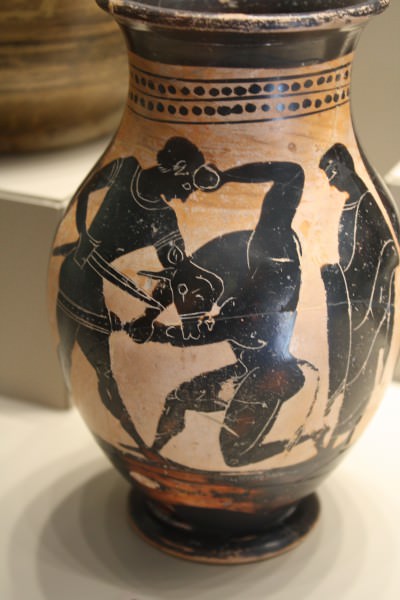
Theseus & the Minotaur
THESEUS IN ART & LITERATURE
Theseus appears, in particular fighting the Minotaur, in Greek art from the last decade of the 6th century BCE. Scenes from the hero's battles on his first journey to Athens were present in relief sculpture on the Hephaesteion of Athens and the Athenian treasury at Delphi - both buildings date to c. 500 BCE - and the temple of Poseidon at Sounion and the heroon at Trysa in Lycia.
The hero's battles with the bull of Marathon and the Minotaur were particularly popular with black-figure vase painters, the finest example being the Francois Vase, which shows many scenes from the Theseus story. Special mention should be given to a magnificent Attic red-figure Kylix, now in the British Museum, which depicts all of the hero's labours. Theseus is distinguished from similar painted scenes of Hercules fighting a bull and centaurs as the former is usually depicted without a beard.
Theseus appears in the tragedies of both Euripides ( Hippolytus and Suppliant Women – where he criticizes tyranny and defends democracy) and Sophocles ( Oedipus at Colonus ). Finally, the labyrinth appeared on Cretan coins, and the motif was also a popular device in Roman art, especially floor mosaics.
LICENSE:
Article based on information obtained from these sources:with permission from the Website Ancient History Encyclopedia
Content is available under License Creative Commons: Attribution-NonCommercial-ShareAlike 3.0 Unported. CC-BY-NC-SA License